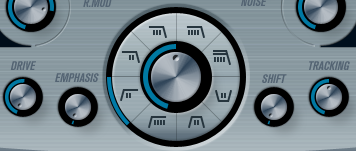Filter Section

The circle in the middle contains the filter parameters. The central control sets the filter cutoff and the outer ring the filter type.
- Filter type
Sets the filter type to low-pass, high-pass, band-pass, or notch.
- Cutoff
Controls the filter frequency or cutoff. If a low-pass filter is used, it can control the opening and closing of the filter, producing the classic sweeping synthesizer sound. How this parameter operates is governed by the filter type.
- Emphasis
This is the resonance control for the filter. For low-pass and high-pass filters, raising the Emphasis value emphasizes the frequencies around the set cutoff frequency. This produces a generally thinner sound, but with a sharper, more pronounced cutoff sweep. The higher the filter Emphasis value, the more resonant the sound becomes until it starts to self-oscillate, generating a distinct pitch. For band-pass or notch filters, the Emphasis setting adjusts the width of the band. If you raise the value, the band where frequencies are let through (band-pass), or cut (notch) becomes narrower.
- Drive
Adjusts the filter input level. Levels above 0 dB gradually introduce a soft distortion of the input signal, and decrease the filter resonance.
- Shift
Internally, each filter consists of two or more subfilters connected in series. This parameter shifts the cutoff frequency of the subfilters. The result depends on the filter type: For low-pass and high-pass filter types, it changes the filter slope. For band-pass and notch filter types, it changes the bandwidth. The Shift parameter has no effect for the filter types 12 dB LP or 12 dB HP.
- Tracking
If this parameter is set to values over the 12 o’clock position, the filter cutoff frequency increases the further up on the keyboard you play. Negative values invert this relationship.
If the Tracking parameter is set fully clockwise, the cutoff frequency tracks the keyboard by a semitone per key.
About the Filter Types
You select the filter type using the buttons around the filter cutoff knob. The following filter types are available (listed clockwise starting from the 9 o’clock position):
- 12 dB LP
Low-pass filters let low frequencies pass and cut out the high frequencies. This low-pass filter has a gentler slope (12 dB/octave above the cutoff frequency), leaving more of the harmonics in the filtered sound.
- 18 dB LP
This low-pass filter also has a cascade design, attenuating frequencies above the cutoff frequency with a 18 dB/octave slope, as used in the classic TB 303 synth.
- 24 dB LP
This filter type attenuates frequencies above the cutoff frequency with a 24 dB/octave slope that produces a warm and fat sound.
- 24 dB LP II
This low-pass filter has a cascade design that attenuates frequencies above the cutoff frequency with a 24 dB/octave slope, which produces a warm and dark sound.
- 12 dB Band
This band-pass filter cuts both high and low frequencies above and below the cutoff frequency with a 12 dB/octave slope, producing a nasal and thin sound.
- 12 dB Notch
This notch filter cuts off frequencies near the cutoff frequency by 12 dB/octave, letting the frequencies below and above through. This produces a phaser-like sound.
- 12 dB HP
A high-pass filter cuts out the lower frequencies and lets the high frequencies pass. This high-pass filter has a 12 dB/octave slope, producing a bright and thin sound.
- 24 dB HP
This filter has a 24 dB/octave slope, producing a bright and sharp sound.